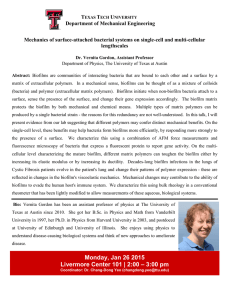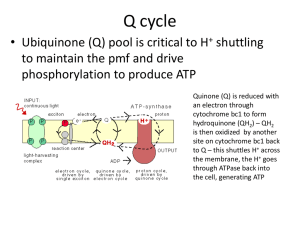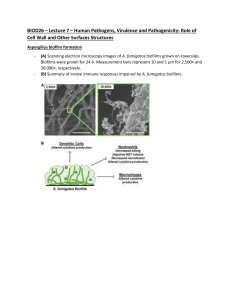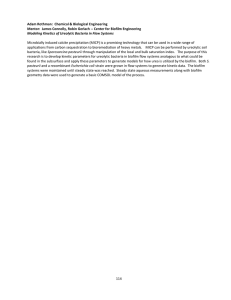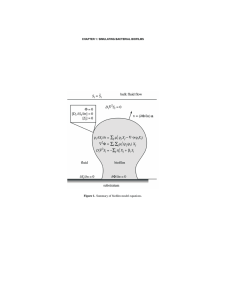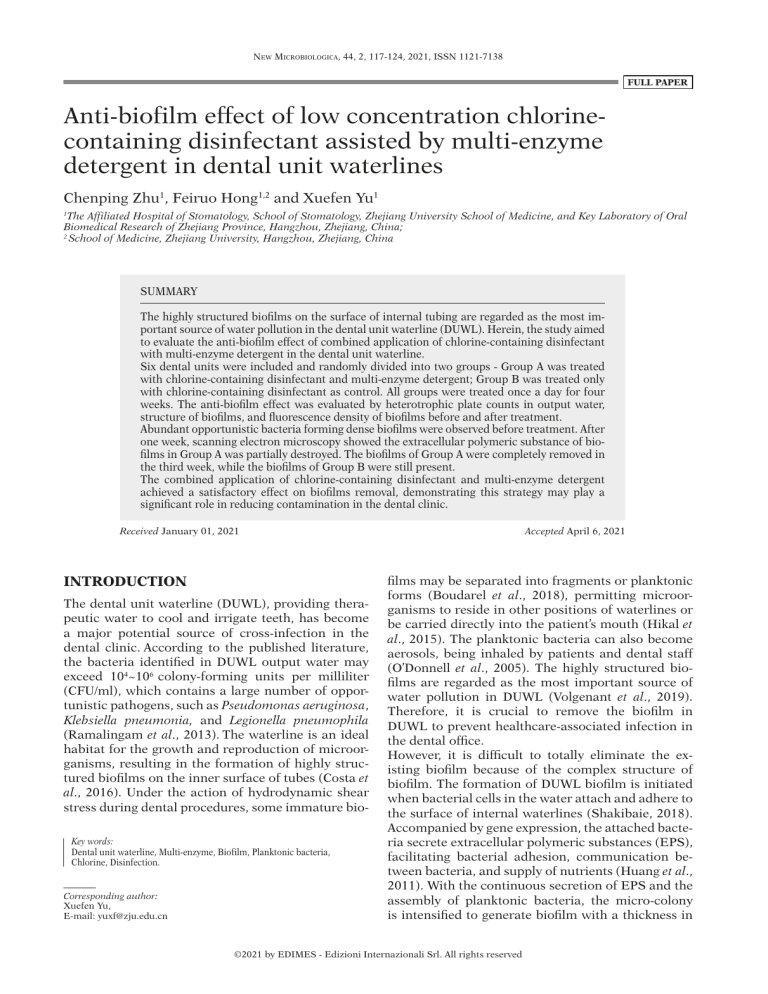
New Microbiologica, 44, 2, 117-124, 2021, ISSN 1121-7138 FULL PAPER Anti-biofilm effect of low concentration chlorinecontaining disinfectant assisted by multi-enzyme detergent in dental unit waterlines Chenping Zhu1, Feiruo Hong1,2 and Xuefen Yu1 The Affiliated Hospital of Stomatology, School of Stomatology, Zhejiang University School of Medicine, and Key Laboratory of Oral Biomedical Research of Zhejiang Province, Hangzhou, Zhejiang, China; 2 School of Medicine, Zhejiang University, Hangzhou, Zhejiang, China 1 SUMMARY The highly structured biofilms on the surface of internal tubing are regarded as the most important source of water pollution in the dental unit waterline (DUWL). Herein, the study aimed to evaluate the anti-biofilm effect of combined application of chlorine-containing disinfectant with multi-enzyme detergent in the dental unit waterline. Six dental units were included and randomly divided into two groups - Group A was treated with chlorine-containing disinfectant and multi-enzyme detergent; Group B was treated only with chlorine-containing disinfectant as control. All groups were treated once a day for four weeks. The anti-biofilm effect was evaluated by heterotrophic plate counts in output water, structure of biofilms, and fluorescence density of biofilms before and after treatment. Abundant opportunistic bacteria forming dense biofilms were observed before treatment. After one week, scanning electron microscopy showed the extracellular polymeric substance of biofilms in Group A was partially destroyed. The biofilms of Group A were completely removed in the third week, while the biofilms of Group B were still present. The combined application of chlorine-containing disinfectant and multi-enzyme detergent achieved a satisfactory effect on biofilms removal, demonstrating this strategy may play a significant role in reducing contamination in the dental clinic. Received January 01, 2021 INTRODUCTION The dental unit waterline (DUWL), providing therapeutic water to cool and irrigate teeth, has become a major potential source of cross-infection in the dental clinic. According to the published literature, the bacteria identified in DUWL output water may exceed 104~106 colony-forming units per milliliter (CFU/ml), which contains a large number of opportunistic pathogens, such as Pseudomonas aeruginosa, Klebsiella pneumonia, and Legionella pneumophila (Ramalingam et al., 2013). The waterline is an ideal habitat for the growth and reproduction of microorganisms, resulting in the formation of highly structured biofilms on the inner surface of tubes (Costa et al., 2016). Under the action of hydrodynamic shear stress during dental procedures, some immature bioKey words: Dental unit waterline, Multi-enzyme, Biofilm, Planktonic bacteria, Chlorine, Disinfection. Corresponding author: Xuefen Yu, E-mail: yuxf@zju.edu.cn Accepted April 6, 2021 films may be separated into fragments or planktonic forms (Boudarel et al., 2018), permitting microorganisms to reside in other positions of waterlines or be carried directly into the patient’s mouth (Hikal et al., 2015). The planktonic bacteria can also become aerosols, being inhaled by patients and dental staff (O’Donnell et al., 2005). The highly structured biofilms are regarded as the most important source of water pollution in DUWL (Volgenant et al., 2019). Therefore, it is crucial to remove the biofilm in DUWL to prevent healthcare-associated infection in the dental office. However, it is difficult to totally eliminate the existing biofilm because of the complex structure of biofilm. The formation of DUWL biofilm is initiated when bacterial cells in the water attach and adhere to the surface of internal waterlines (Shakibaie, 2018). Accompanied by gene expression, the attached bacteria secrete extracellular polymeric substances (EPS), facilitating bacterial adhesion, communication between bacteria, and supply of nutrients (Huang et al., 2011). With the continuous secretion of EPS and the assembly of planktonic bacteria, the micro-colony is intensified to generate biofilm with a thickness in ©2021 by EDIMES - Edizioni Internazionali Srl. All rights reserved 118 Chenping Zhu, Feiruo Hong, Xuefen Yu the range of 30~50 μm (Walker et al., 2007). It has been suggested that the resistance to antibiotics of bacterial cells in mature biofilms is 10 to 1000 times higher than that of planktonic bacteria, and biofilms play an important role in cross-infection in dentistry (Wróblewska et al., 2015). Chlorine-containing disinfectant is one of the most commonly used DUWL disinfectants in dental practice (Shajahan et al., 2017). Its active ingredient is stable hypochlorous acid, which is a strong oxidizing agent that can kill pathogens by destroying the oxidative phosphorylation and metabolic pathways involved in the production of Adenosine triphosphate (ATP) (Shajahan et al., 2016; Shajahan et al., 2017). However, the chlorine-containing disinfectants at the manufacturer’s recommended concentration have a corrosive effect on metal parts of dental units (Romanovski et al., 2020). Multi-enzyme detergent has achieved high efficiency in the cleaning of endoscopes and surgical instruments, but they have not been applied to DUWL (Hadi et al., 2010). It has been demonstrated that the incorporation of appropriate enzymes into disinfectant agents can significantly improve biofilm removal performance (Stiefel et al., 2016). Therefore, this study adopted the combined application of low-concentration chlorine-containing disinfectant and multi-enzyme detergent to investigate the anti-biofilm effect of this method, thus further exploring appropriate and feasible disinfection methods in DUWL. In addition, the contamination of DUWL was evaluated and characterized using bacterial colony counts and species identification analysis. MATERIALS AND METHODS From March 2019 to December 2019, a total of six dental units were selected as the study objects and divided randomly into two groups to evaluate the effectiveness of the two disinfection methods. All dental units, supplied from municipal main water treated by a large-scale reverse osmosis water system, had been in regular use for more than one year at a stomatology hospital in Zhejiang, China. Disinfections in both groups were all performed as per the instructions of manufacturers after daily treatment lasting for four weeks. The anti-suction handpieces and the tubes of the dental units were flushed by pressing the foot pedal switch at the beginning of the day for 3 mins and between two patients for 20 secs. 1) Group A (n=3): The DUWLs were flushed with 1:100 diluted low-foaming multi-enzyme detergent (Clean Tree Enzymatic®, USA) in water reservoirs for 3 mins, and then defoam for 15 mins to flush with purified water for 3 mins. After cleaning the water reservoir, the waterlines were flushed with chlorine-containing disinfectant (KONVIDA®, HangZhou) at low concentration (20 mg/L) for 3 mins, followed by defoaming for 15 mins, and then flushed with purified water for 3 mins. 2) Group B (n=3): Except for the purified water instead of 1:100 diluted multi-enzyme detergent, the other disinfection steps were the same as in Group A (Figure1). The concentration and application procedure of multi-enzyme detergent and chlorine-containing disinfectant was in accordance with the instructions of manufacturers. Moreover, the flow rate of flushing fluid was 35 mL/min for all dental units. During the study period, each dental unit was used to treat 12 to 13 patients per day, and the treatment of each patient lasted for about 25-30 mins. Each dental unit used reverse osmosis water from the hospital’s centralized water system during treatment and switched to a separate reservoir during disinfection. At the beginning of each week, usually before the first patient’s visit, output water and biofilm samples of each dental unit were taken. Samples were also collected before the start of disinfection as control. Output water samples were taken from handpieces. The water outlets were disinfected by cotton balls soaked with 75% alcohol, followed by discharging water for 30 seconds. Then, each water sample was collected in a sterile airtight test bottle containing sodium thiosulfate (20 mg/L), neutralizing the residual chlorine present in the water. Biofilm samples were collected from the waterlines of dental units connecting with handpieces. After discarding the first one centimeter (cm) of tubes, two adjacent sections of one cm tubes were taken as samples. One of the samples was stored in sterile normal saline (NS) at 4°C, preparing for biofilm structure observation. Meanwhile, another tube sample was cut longitudinally, and the inner surfaces were scraped into the 2 ml NS with sterile loops, followed by full elution with an electronic shaker, used to identify the species of bacteria in the biofilm. These aforementioned procedures were all performed under sterile conditions. The following outcome parameters were examined for these samples: 1) Species analysis of bacteria: To identify the bacteria species in the output water and biofilm of DUWL before and after disinfection, matrix-assisted laser desorption ionization-time of flight mass spectrometry (MALDI-TOF-MS, VITEK®MS, France) was used. 200 μl of NS containing biofilm sample and output water sample were inoculated into Reasoner’s 2A (R2A) agar media (Hanghui®, Hangzhou), blood agar media (Hanghui®, Hangzhou), and MacConkey agar media (HKM®, Guangdong), respectively. R2A agar plates were incubated at 20°C, while blood agar plates and MacConkey plates were incubated at 37°C. Single colonies of different morphologies and colors in the plates were selected within 72 h and then coated on the target plates. After Figure 1 - Disinfection process of two groups. Multi-enzyme detergent in DUWL 119 Figure 1 - Disinfection process of two groups. drying, each bacteria target was coated with 1 3) Structure of biofilm: The tube samples stored in μl VITKE® MS - CHCA substrate liquid. E. coli NS were cut into 5 mm-thick pieces and washed (ATCC8739) was regarded as a quality control with phosphate buffer saline (PBS) solution. The bacterium. Credible values (percent) were used samples were then fixed with 2.5% glutaraldeas the consistency criteria for the sample and hyde in PBS solution for more than 4 h at 4°C standard map. Credible value < 60.0% showed and then washed three times with PBS solution unreliable test results, credible value between for 15 mins each time. Afterward, they were fixed 60.0% to 99.9% displayed reliable testing results. with 1% osmic acid for 1.5 h and washed three The mass spectrum of the bacteria samples was times with PBS solution for 15 mins each time. compared to more than 4000 standard spectra The samples were dehydrated in a gradient series stored in the database. Investigating the presence of ethanol (30%, 50%, 70%, 90%, and 100%) for of Legionella pneumophila: Water samples (500 15 mins each time and transferred to a mixture ml) were filtered through 0.2µm isopore polycarof alcohol and isoamyl acetate for 1 h. Drying bonate membranes. Filter membranes were then with CO2 critical point dryer (Hitachi HCP-2, suspended in 10 ml of the same water sample and Japan), the inner surfaces of tubes were coated vortexed. 100 μl of the suspension were inoculatwith gold-palladium in ion sputter for 4-5 mins to ed on BCYE agar plates and GVPC agar plates observe in scanning electron microscopy (SEM, (HKM®, Guangdong) for 10 days of incubation at Hitachi TM-1000, Japan). 4) Fluorescence density of biofilm: The remaining 37°C in a damp environment under 5% CO2. tube samples were stained with fluorescent yel2) Total viable counts (TVC): 1 ml of 10-fold diluted low stain for 20 mins of incubation at 37°C. They and 1 ml 100-fold diluted output water samples were then rinsed with tris buffered saline tween were seeded on 18-20 ml of R2A medium by pour(TBST) solution and PBS solution alternately, ing method for 7 days of incubation at 20°C. Each followed by placement in a thermostat to dry sample was inoculated twice to calculate the aver1 thoroughly. The tube samples were cut to obtain age. According to the relevant Chinese standard, a sections with a thickness of about 0.5 mm. The limit of 100 CFU/ml on the heterotrophic bacteribiofilms in cross-sections were observed and pical load was accepted. 120 Chenping Zhu, Feiruo Hong, Xuefen Yu tures were taken using a laser scanning confocal microscope (LSCM, ZeissLSM-780, Germany). The fluorescence density in images of biofilm was calculated by Image-Pro Plus 6.0 software. All statistical analyses were performed using SPSS version 20.0 (IBM Inc., Armonk, USA). The statistical significance level chosen for all analyses was 0.05. Using the Shapiro-Wilk test, we found the TVC of some output water samples and the fluorescence density values of some biofilm samples were not normally distributed (P<0.05), so the Mann-Whitney U test was applied to compare the differences. RESULTS Table 1 shows the comparison of pathogenic bacterial strains in DUWL before and after disinfection. There were many opportunistic pathogens in DUWL before Table 1 - The pathogenic bacteria strains in biofilm and water samples Species of opportunistic pathogens Staphylococcus spp. Staphylococcus epidermidis Staphylococcus capitis Staphylococcus warneri Staphylococcus saprophyticus Staphylococcus equorum Enterobacter spp. Enterobacter cloacae Enterobacter asburiae Methylobacterium spp. Methylobacterium fujisawaense Methylobacterium radiotolerans Ralstonia spp. Ralstonia pickettii Ralstonia mannitolilytica Micrococcus spp. Micrococcus luteus Paracoccus spp. Paracoccus yeei Sphingomonas spp. Sphingomona sechinoides Acidovorax spp. Acidovorax temperans Delftia spp. Delftia acidovorans Cupriavidus spp. Cupriavidus pauculus Bacillus spp. Bacillus cereus group TOTAL Before/ (Group A After, Group B After) Biofilm Output water (strains) (strains) 9/ (0,0) 3/ (0,0) 6/ (0,0) 5/ (0,0) - 2/ (0,0) 2/ (0,0) 3/ (0,0) - 4/ (0,0) 1/ (0,0) - 3/ (0,0) 10/ (0,0) - 3/ (0,0) 5/ (0,0) 3/ (0,0) - - 1/ (0,0) - 4/ (0,0) 1/ (1,1) 2/ (0,1) - 1/ (0,0) - 1/ (0,0) 16/ (0,2) 62/ (1,3) 23/ (0,1) *The Before/ (Group A After, Group B After) of Fungus’ strains in biofilm is 6/(0,1) and in output water is 5/(0,1). disinfection, where 11 families, 18 species, and 85 strains of bacteria were detected. Staphylococcus spp., Enterobacter spp., Bacillus cereus group, and other species were detected in the biofilm attached to the inner surface of tubes. In addition, the planktonic bacteria in output water were mainly gram-positive, including Staphylococcus spp., Bacillus spp., Micrococcus spp. The common bacteria species detected in both samples were Methylobacterium fujisawaense, Ralstonia pickettii and Acidovorax temperans. Furthermore, fungi were present in both biofilms and output water samples. However, Legionella was not detected in all samples. The number of pathogenic bacteria in biofilm samples was higher than that in output water samples. After 4 weeks of disinfection, Acidovorax temperans, Bacillus cereus group, and Fungus were still present in DUWL of Group B while only Acidovorax temperans was detected in DUWL of Group A. Moreover, no pathogenic bacteria were detected in the output water samples of Group A. The TVC of output water samples of two groups from different time points are shown in Table 2. The median TVC of output water samples greatly exceeded the qualified standard of 100 CFU/mL, suggesting the water from the two groups was all seriously microbially contaminated before disinfection. After the first week of disinfection, the number of planktonic bacteria in both groups gradually decreased to the standard level. However, the median count of planktonic bacteria in Group A was re-unqualified after three weeks of disinfection, achieving 602.5 CFU/ mL, and returned to under 100 CFU/mL after disinfection for four weeks. In contrast, the median TVC of Group B was kept below 100 CFU/mL after two weeks of disinfection. Comparing the median TVC of each group before and after four weeks of disinfection, there were significant differences (P<0.001), but there was no significant difference between the two groups (P=0.34). Figure 2 and Figure 3 show the structures of biofilms on the inner surface of the tubes under different magnifications using SEM, respectively. The waterlines of both groups were seriously polluted by biofilms before treatment. The SEM analysis showed that there were many mound-shaped raised biofilms attached to the inner surface of the tubes, some of which protruded into the lumen like dendrites. Different forms of bacteria and micro-colonies in the biofilms were embedded by lots of organic substrates, forming a compact structure. The LSCM analysis also showed that before disinfection the inner surfaces of the tubes from two groups were seriously contaminated by continuous biofilms with an uneven density, which looked like bands of numerous hump-like ridges and dendritic protrusions. After one week of disinfection, the bacteria in the biofilms of Group A remained deep only in the EPS matrix. On the contrary, there were still abundant bacteria in the 121 Multi-enzyme detergent in DUWL Table 2 - The TVC of output water samples from different time points (P50 (P25, P75))(CFU/ml) Group Group A Group B P Baseline 900.00 (367.50,1422.50) 858.00 (442.50,1402.00) 0.686 Week 1 62.50 (57.50,127.50) 71.50 (67.50,134.00) 0.403 Time of treatment Week 2 115.00 (88.50,135.00) 48.50 (39.50,60.00) 0.029 Week 3 602.50 (267.50,857.50) 15.00 (12.50,62.50) <0.001 Week 4 38.50 (32.50,82.50) 22.50 (12.50,37.50) 0.340 P (baseline and week 4) <0.001 <0.001 biofilms of Group B, and the EPS between bacte- the biofilm samples in the third and fourth weeks. ria was still obvious. The quantity and structure of Nevertheless, the LSCM analysis illustrated that albiofilms of the two groups were both reduced and though the biofilms of Group B decreased gradualdestroyed slightly after one week of disinfection, of ly in the third week, they were still clearly present Figure - SEM images biofilmobvious. structures After on the inner (×10000). Group A which2Group A wasofmore two surface weeks of tubes on the inner(a) surface of the tubes in the fourth week, of disinfection, the quantity and structure of biofilms while the biofilms of Group A were completely rebefore disinfection; (b) Group A after one week; (c) Group A after two weeks; (d) Group B before in Group A were visually less and looser than those moved in the third week (Figure 4). in Group B. Unfortunately, due (f) to Group experimental TableEPS 3 shows difference in fluorescence densidisinfection; (e) Group B after one week; B after two opweeks (The betweenthe bacteria erations, we were unable to save the SEM images of ty values between the two groups. The median valis indicated by the white arrow.) Figure 3 - SEM images of structures of biofilm on the inner surface of tubes (×30). (a) Group A Figure 2 - SEM images of biofilm structures on the inner surface of tubes (×10000). (a) Group A before disinfection; (b) Group A after one week; (c) Group A after two weeks; (d) Group B before disinfection; (e) Group B after one week; (f) Group B after two weeks (The EPS between bacteria is indicated by the white arrow). before disinfection; (b) Group A after one week; (c) Group A after two weeks; (d) Group B before disinfection; (e) Group B after one week; (f) Group B after two weeks. Figure 3 - SEM images of structures of biofilm on the inner surface of tubes (×30). (a) Group A before disinfection; (b) Group A after one week; (c) Group A after two weeks; (d) Group B before disinfection; (e) Group B after one week; (f) Group B after two weeks. 2 yellow stain (×20). (a, f) Group A and Group B before disinfection. (b, c, d, e); Group A was disinfected for 1-4 weeks, respectively (g, h, i, j), Group B was disinfected for 1-4 weeks, 122 Zhu, Feiruo Hong, Xuefen Yu respectively(The red arrow indicates theChenping last residual biofilm). Figure 4 - LSCM images of biofilms on the inner surface of tubes after staining with fluorescent yellow stain (×20). (a, f) Group A and Group B before disinfection. (b, c, d, e); Group A was disinfected for 1-4 weeks, respectively (g, h, i, j), Group B was disinfected for 1-4 weeks, respectively (The red arrow indicates the last residual biofilm) Table 3 - The fluorescence density values of the two groups (P50 (P25, P75)) Group Group A Group B P Baseline 46.84 (22.00, 130.76) 60.70 (30.47, 241.24) 0.182 Week 1 125.03 (65.85, 135.91) 75.84 (23.90, 187.24) 0.509 ues of the two groups before disinfection were not statistically significant (P>0.05), indicating that the baselines were consistent and could be compared. There was no significant difference in fluorescence intensity between the two groups after one week of disinfection (P>0.05), while the difference was statistically significant after two weeks of disinfection (p<0.05). As there was no fluorescence in Group A after three weeks of disinfection, we cannot compare the difference between the two groups in the third and fourth weeks. DISCUSSION DUWL is contaminated by a wide array of bacteria, 4 fungi, and protozoa, including both environmental and opportunistic pathogens, predominantly Grampositive bacteria, which poses a potential hazard to the health of dental patients and medical staff (Volgenant et al., 2019; Walker et al., 2007; O’Donnell et al., 2011). Our study confirmed that the waterlines were seriously contaminated by a large number of heterotrophic bacteria and biofilms formed by these bacteria. The result of MALDI-TOF-MS in this study showed there were multiple drug-resistant pathogens Time of treatment Week 2 32.33 (22.30, 46.26) 124.61 (47.44, 214.83) 0.025 Week 3 Week 4 -- -- 30.42 (19.13, 448.31) -- 54.29 (25.20, 383.55) -- in biofilms and water samples, such as coagulase-negative staphylococci (CoNS), Enterobacter cloacae, R. pickettii, and Fungi. Nosocomial infections caused by CoNS most often occur after implantation of medical devices and are usually attributed to the biofilm formed by CoNS (Fredheim et al., 2009). CoNS have a strong potential to form biofilm and also have high proportions of resistance to fosfomycin and penicillin (Socohou et al., 2020). According to the Chinese rules concerning the quality of dental water (2006), Enterobacter must not be present. However, Enterobacter was detected in the biofilm samples in our study. As Gram-negative bacilli, Rolstonia spp. are increasingly recognized as emerging nosocomial pathogens (Nasir et al., 2019). R. pickettii is the most clinically common pathogen of the Rolstonia spp., which has caused several outbreak events of infection in the hospital through the contamination of pharmaceutical solutions (Chen et al., 2017). The dental office environment provides suitable conditions for the emergence of fungal biofilms, which can promote fungal contamination. Studies have shown that all Candida isolates can grow as biofilms (Damasceno et al., 2017). In this study, L. pneumophila was not isolated from any of the samples, which Multi-enzyme detergent in DUWL was not similar to that reported by other researchers. Up to 40% of dental units reached values of L. pneumophila >103CFU/L as reported by Aprea et al. (2010), while Arvand et al. (2013) detected Legionella spp. in 27.8% of water samples of DUWL. The absence of L. pneumophilain may be ascribed to regional differences and its water source supplied from the hospital’s centralized water system. The TVC of planktonic bacteria in both groups exceeded the qualified water standard of 100 CFU/mL before treatment. After one week of disinfection, the TVC of planktonic bacteria gradually decreased to standard with the removal of biofilms, indicating that there was a positive correlation between the TVC of planktonic bacteria and biofilm contamination. However, we found that the TVC of planktonic bacteria in Group A was unqualified again with the decrease of biofilms in the third week. The increase of the TVC of planktonic bacteria might be due to the rupture of the deep structure of biofilms and the dissolution of EPS produced by multi-enzyme detergents and high viscosity aqueous solutions (Zhang et al., 2003), but the rinsing flow rate of disinfectant was not high enough to eliminate the decomposed biofilms. Moreover, the low-concentration chlorine-containing disinfectant used in this study might be unable to withstand such a dense bacterial load. As for the comparison between the two groups, the reason for the insignificant difference might also be that the destruction of the deep structure of biofilm in Group A increased planktonic bacteria, as well as insufficient experiment time (only four weeks). Biofilm is a cluster of microbial communities attached to a surface and/or to each other embedded in a self-produced extracellular matrix (Vestby et al., 2020). Before disinfection, it was observed by SEM that the biofilms on the inner surface of tubes were abundant and dense, and various bacteria in the inner layer were tightly embedded in EPS, which made it difficult to remove. EPS is the most important component to support the structure of biofilms, which can also be used as an intramolecular bridge (Rabin et al., 2015). Polysaccharides are the major component of the EPS matrix in most biofilms. They play a fundamental role in transferring nutrients between bacteria. Proteins in EPS also play a critical role, attaching to the cell surface to enhance the formation and stability of biofilms (Fulaz et al., 2019). In this study, using multi-enzyme detergent and chlorine-containing disinfectant for a defined period of time allowed the biofilm with less adhesion than the shear force to be significantly removed by rinsing. The affinity of multi-enzyme detergent was attributed to the action of individual ingredients, including triple enzymes of polysaccharides, proteins, and lipids. The result of our study was similar to the study conducted by Stiefel et al., (2016) who demonstrated that an enzymatic endoscope cleaner achieved effective 123 disinfection by removing more than 99% of CFU and more than 90% of extracellular polymeric substances. A review concluded that the application of multi-enzyme formulations that contain enzymes capable of degrading microbial DNA, polysaccharides, proteins, and quorum-sensing molecules can successfully remove complex biofilms (Thallinger et al., 2013). Finally, this study has some limitations. First, the main limitation was the small sample size, mainly due to the restriction of objective conditions. Second, the treatment time, only four weeks, was relatively short to observe the long-term effect, which may also have a certain impact on the comparison of the TVC of planktonic bacteria in water samples. In summary, the present study confirmed that the DUWL was seriously contaminated by a large number of bacteria and the biofilm formed by them, including some opportunistic pathogens. SEM images of biofilm samples showed the pathogens of coccus, bacillus, and spirilla were encapsulated by EPS and mixed with organic matrix to form compact structures of biofilms. The combined application of low-concentration chlorine-containing disinfectant and multi-enzyme detergent can play a critical role in decontaminating DUWL, especially the destruction of the biofilm structures. EPS and organic substrates embedded in the biofilm gradually decompose under the action of multi-enzyme detergent. Then the chlorine-containing disinfectant can enter the biofilm more easily and effectively kill the bacteria in the deep layer to achieve removal of the biofilm. This study demonstrated the effect of combined application of multi-enzyme detergent and chlorine-containing disinfectant on the removal of biofilms, but this disinfection strategy should also be carried out with the help of a large amount of flushing water in order to thoroughly discharge the shed biofilms. Furthermore, the frequency of use of this method and its long-term effect on disinfection should be further discussed in future research. Acknowledgments The authors are grateful to Electron Microscopy Center in Zhejiang University. This work was supported by the Health Bureau of Zhejiang Province under Grant (Contract No.2018KY498) and Zhejiang Province Public Welfare Technology Application Research Project under Grant (LGF21H190003). References Aprea L., Cannova L., Firenze A., Bivona M.S., Amodio E., et al. (2010). Can technical, functional and structural characteristics of dental units predict Legionella pneumophila and Pseudomonas aeruginosa contamination? J Oral Sci. 52, 641646. Arvand M., Hack A. (2013). Microbial contamination of dental unit waterlines in dental practices in Hesse Germany: A cross - sectional study. Eur J Microbiol Immunol. 3, 49-52. Boudarel H., Mathias J., Blaysat B., Grédiac M. (2018). Towards standardized mechanical characterization of microbial bio- 124 Chenping Zhu, Feiruo Hong, Xuefen Yu films: analysis and critical review. Npj Biofilms Microbi. 4, 17. Chen Y.Y., Huang W.T., Chen C.P., Sun S.M., Kuo F.M., et al. (2017). An outbreak of ralstonia pickettii bloodstream infection associated with an intrinsically contaminated normal saline solution. Infect Control Hosp Epidemiol. 38, 444-448. China National Standardization Management Committee. (2006). Standards for Drinking Water quality. GB 5749-2006. Costa D., Girardot M., Bertaux J., Verdon J., Imbert C. (2016). Efficacy of dental unit waterlines disinfectants on a polymicrobial biofilm. Water Res. 91, 38-44. Damasceno J.L., Dos Santos R.A., Barbosa A.H., Casemiro L.A, Pires R.H., et al. (2017). Risk of fungal infection to dental patients. Sci World J. 2017, 2982478. Fredheim E.G.A., Klingenberg C., Rohde H., Frankenberger S., Gaustad P., et al. (2009). Biofilm formation by Staphylococcus haemolyticus. J Clin Microbiol. 47, 1172. Fulaz S., Vitale S., Quinn L., Casey E. (2019). Nanoparticle–biofilm interactions: the role of the EPS matrix. Trends Microbiol. 27, 915-926. Hadi R., Vickery K., Deva A., Charlton T. (2010). Biofilm removal by medical device cleaners: comparison of two bioreactor detection assays. J Hosp Infect. 74, 160-167. Hikal W., Zaki B., Sabry H. (2015). Evaluation of ozone application in dental unit water lines contaminated with pathogenic acanthamoeba. Iran J Parasitol. 10, 410-419. Huang R., Li M., Gregory R.L. (2011). Bacterial interactions in dental biofilm. Virulence. 2, 435-444. Nasir N., Sayeed M.A., Jamil B. (2019). Ralstonia pickettii bacteremia: an emerging infection in a tertiary care hospital setting. Cureus. 11, e5084. O’Donnell M.J., Tuttlebee C.M., Falkiner F.R., Coleman D.C. (2005). Bacterial contamination of dental chair units in a modern dental hospital caused by leakage from suction system hoses containing extensive biofilm. J Hosp Infect. 59, 348-360. O’Donnell M.J., Boyle M.A., Russell R.J., Coleman D.C. (2011). Management of dental unit waterline biofilms in the 21st century. Future Microbiol. 6, 1209-1226. Rabin N., Zheng Y., Opoku-Temeng C., Du Y, Bonsu E., et al. (2015). Biofilm formation mechanisms and targets for developing antibiofilm agents. Future Med Chem. 7, 493-512. Ramalingam K., Frohlich N.C., Lee V.A. (2013). Effect of nano- emulsion on dental unit waterline biofilm. J Dent Sci. 8, 333336. Romanovski V., Claesson P.M., Hedberg Y.S. (2020). Comparison of different surface disinfection treatments of drinking water facilities from a corrosion and environmental perspective. Environ Sci Pollut Res. 27, 12704-12716. Shajahan I.F., Kandaswamy D., Srikanth P., Narayana L.L., Selvarajan R. (2016). Dental unit waterlines disinfection using hypochlorous acid-based disinfectant. J Conserv Dent. 19, 347350. Shajahan I.F., Kandaswamy D., Lakshminarayanan L., Selvarajan R. (2017). Substantivity of hypochlorous acid-based disinfectant against biofilm formation in the dental unit waterlines. J Conserv Dent. 20, 2-5. Shakibaie M.R. (2018). Bacterial biofilm and its clinical implications. Ann Microbiol Res. 2, 45-50. Socohou A., Sina H., Degbey C., Nanoukon C., Chabi-Sika K., et al. (2020). Antibiotics Resistance and Biofilm Formation Capacity of Staphylococcus spp. Strains Isolated from Surfaces and Medicotechnical Materials. Int J Microbiol. 2020, 6512106. Stiefel P., Mauerhofer S., Schneider J., Maniura-Weber K., Rosenberg U., et al. (2016). Enzymes enhance biofilm removal efficiency of cleaners. Antimicrob Agents Chemother 60, 36473652. Thallinger B., Prasetyo E.N., Nyanhongo G.S., Guebitz G.M. (2013). Antimicrobial enzymes: an emerging strategy to fight microbes and microbial biofilms. Biotechnol J. 8, 97-109. Vestby L.K., Grønseth T., Simm R., Nesse L.L. (2020). Bacterial biofilm and its role in the pathogenesis of disease. Antibiotics. 9, 59. Volgenant C.M.C., Persoon I.F. (2019). Microbial water quality management of dental unit water lines at a dental school. J Hosp Infect. 103, e115-e117. Walker J.T., Marsh P.D. (2007). Microbial biofilm formation in DUWS and their control using disinfectants. J Dent. 35, 721730. Wróblewska M., Strużycka, Mierzwińska-Nastalska E. (2015). Significance of biofilms in dentistry. Przegl Epidemiol. 69, 739744. Zhang X., Bishop P.L. (2003). Biodegradability of biofilm extracellular polymeric substances. Chemosphere. 50, 63-69.
